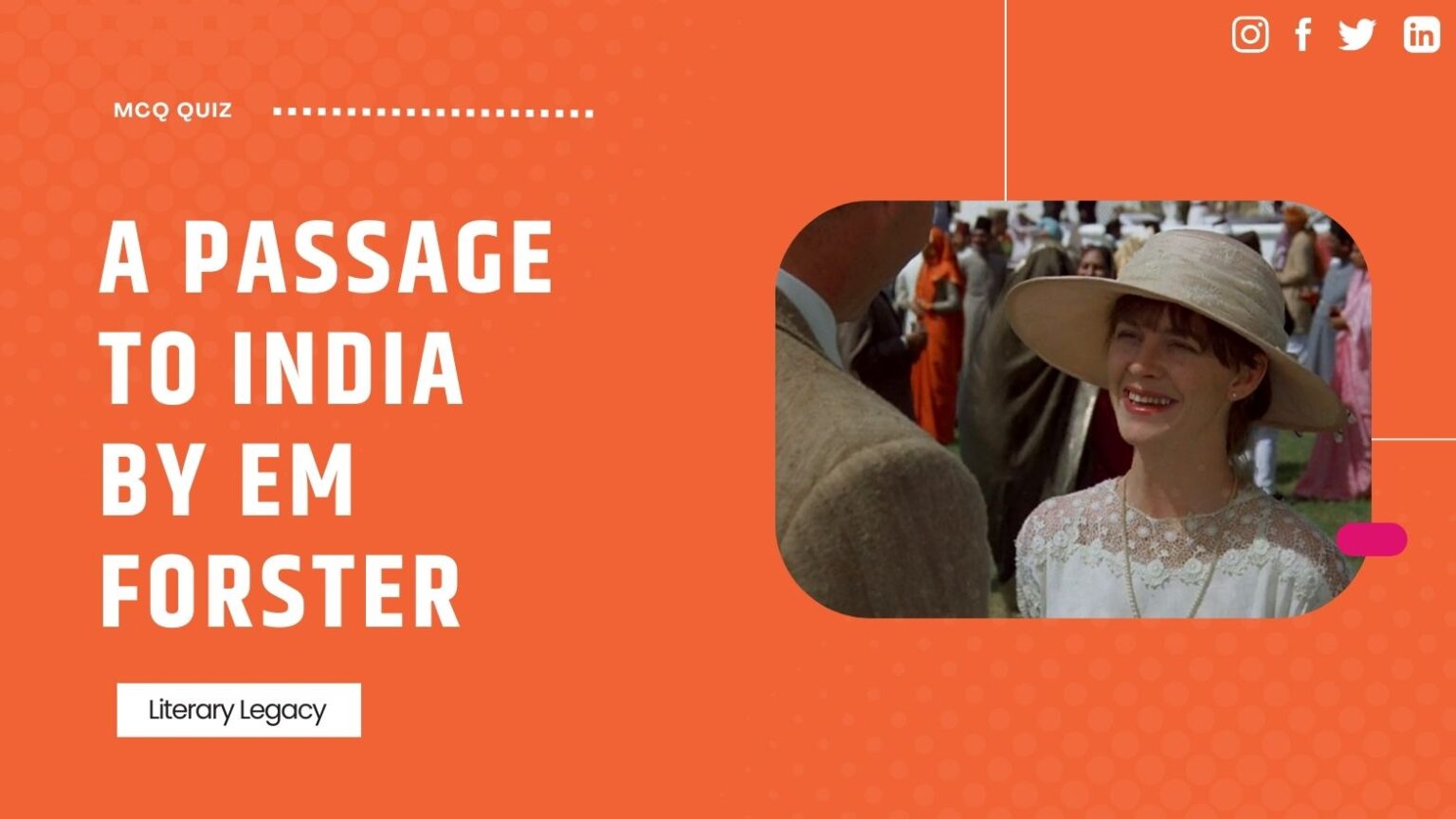1. What does Aziz find amusing but often condescending about the English?
A) Their attitudes
B) Their sense of humor
C) Their manners
D) Their accents
Answer: (A)
Their attitudes
Aziz perceives the English as amusing yet rude due to their condescending attitudes.
2. Which character plans to marry Ronny Heaslop?
A) Aziz
B) Professor Godbole
C) Adela Quested
D) Mrs. Moore
Answer: (C)
Adela Quested
Adela Quested plans to marry Ronny Heaslop, who is Mrs. Moore’s son.
3. How does Mrs. Moore feel when she meets Aziz in the mosque?
A) Indifferent
B) Hostile
C) Amused
D) Connected
Answer: (D)
Connected
Mrs. Moore feels an instant connection with Aziz when they meet in the mosque.
4. What happens when Ronny arrives at the party hosted by Mr. Turton?
A) He leaves immediately.
B) He and Aziz argue.
C) He is rude to the Indians.
D) He befriends the Indians.
Answer: (C)
He is rude to the Indians.
Ronny is rude to the Indians when he arrives at the party, creating tension.
5. What prompts Adela to break up with Ronny?
A) Her feelings for Aziz
B) Her experiences in India
C) A conversation with Mrs. Moore
D) Ronny’s behavior
Answer: (B)
Her experiences in India
Adela reflects on her experiences in India and decides not to marry Ronny.
6. What significant event occurs during Adela’s day trip to the Marabar Caves?
A) She declares her love for Aziz.
B) She is offended by Aziz’s comments.
C) She disappears from Aziz’s sight.
D) She loses her way in the caves.
Answer: (C)
She disappears from Aziz’s sight.
During the trip, Adela vanishes from Aziz’s sight after a significant moment.
7. What animal does Adela’s car crash into during their excursion?
A) A cow
B) An elephant
C) A horse
D) A mysterious animal
Answer: (D)
A mysterious animal
The car crashes into a mysterious animal, leading to a turning point in Adela’s thoughts.
8. What effect does the cave’s echo have on Mrs. Moore?
A) It makes her excited.
B) It calms her down.
C) It disturbs her.
D) It fascinates her.
Answer: (C)
It disturbs her.
Mrs. Moore is disturbed by the caves’ echo, which affects her emotional state.
9. What item belonging to Adela does Aziz find after she goes missing?
A) Her diary
B) Her scarf
C) Her hat
D) Her broken field-glasses
Answer: (D)
Her broken field-glasses
Aziz discovers Adela’s broken field-glasses, indicating something troubling has occurred.
10. What leads to Aziz’s arrest?
A) A fight with Fielding
B) A misunderstanding with Ronny
C) An accusation of assaulting Adela
D) Losing a valuable item
Answer: (C)
An accusation of assaulting Adela
Aziz is arrested and charged with assaulting Adela, which creates a central conflict.
11. What is Mr. McBryde’s theory regarding the behavior of Indians?
A) They behave criminally due to poor education.
B) Their cultural background influences their behavior.
C) The climate of India causes them to behave criminally.
D) They are inherently predisposed to crime.
Answer: (C)
The climate of India causes them to behave criminally.
Mr. McBryde believes that India’s climate affects the behavior of Indians.
12. How is Miss Derek regarded by many of the English in Chandrapore?
A) As a role model for young Englishwomen.
B) As a troublesome influence for the Maharani.
C) As a model of propriety and grace.
D) As unseemly for her carefree behavior.
Answer: (D)
As unseemly for her carefree behavior.
Miss Derek’s outgoing nature and behavior lead many to consider her unseemly.
13. What is the relationship between Aziz and Hamidullah?
A) They are friends and uncle-nephew.
B) They have a strained relationship due to cultural differences.
C) They are cousins.
D) They are professional rivals.
Answer: (A)
They are friends and uncle-nephew.
Hamidullah is Aziz’s uncle and also a close friend.
14. What best describes Major Callendar’s attitude toward Indians?
A) He is compassionate and understanding.
B) He is supportive and open-minded.
C) He is condescending and prejudiced.
D) He is indifferent and apathetic.
Answer: (C)
He is condescending and prejudiced.
Major Callendar is noted for his condescending and prejudiced views of Indians.
15. What role does the Nawab Bahadur (Mr. Zulfiqar) assume in relation to British rule?
A) He is indifferent to political matters.
B) He is a revolutionary leader seeking independence.
C) He is a prominent anti-British activist.
D) He is a loyalist supportive of British rule.
Answer: (D)
He is a loyalist supportive of British rule.
Nawab Bahadur is a prominent Indian supporter of British rule.
16. What significant event is associated with Professor Godbole?
A) He teaches English literature at Fielding’s college.
B) He leads a movement for Indian independence.
C) He experiences religious ecstasy at a festival.
D) He is involved in a political uprising.
Answer: (C)
He experiences religious ecstasy at a festival.
Professor Godbole is known for experiencing religious ecstasy at a Hindu festival.
17. Which character is known for their vocal dislike of Indians?
A) Stella Moore
B) Mrs. Turton
C) Adela Quested
D) Miss Derek
Answer: (B)
Mrs. Turton
Mrs. Turton is outspoken in her hatred of Indians.
18. What is the relationship between Ralph Moore and Mrs. Moore?
A) He is her cousin.
B) He is her husband.
C) He is her son.
D) They are siblings.
Answer: (C)
He is her son.
Ralph Moore is Mrs. Moore’s sensitive son.
19. Who is described as dramatic and anti-English after Aziz’s trial?
A) Aziz
B) Mahmoud Ali
C) Mr. Turton
D) Hamidullah
Answer: (B)
Mahmoud Ali
Mahmoud Ali is known for being dramatic and passionately anti-English.
20. What is a common trait shared by Mr. and Mrs. Bhattacharya?
A) They are friendly and welcoming to Adela.
B) They are outspoken critics of British rule.
C) They are both English missionaries.
D) They are wealthy aristocrats.
Answer: (A)
They are friendly and welcoming to Adela.
Mr. and Mrs. Bhattacharya are a friendly couple whom Adela meets.
21. What does Fielding believe about Aziz’s involvement in the incident?
A) Aziz is innocent.
B) Aziz should be punished regardless of guilt.
C) Aziz is guilty of the accusations.
D) Fielding is unsure about Aziz’s actions.
Answer: (A)
Aziz is innocent.
Fielding defends Aziz, indicating his belief in Aziz’s innocence.
22. What emotional state does Mrs. Moore experience as a result of the cave’s echo?
A) A peaceful acceptance of her surroundings.
B) Increased excitement for India.
C) Haunting feelings leading to irritability.
D) A sense of wonder and discovery.
Answer: (C)
Haunting feelings leading to irritability.
Mrs. Moore becomes haunted by the echo, contributing to her irritability and apathy.
23. What ultimately causes Adela to break off her engagement with Ronny?
A) Fielding’s influence on her decisions.
B) Tensions with her family regarding the engagement.
C) Her experience in the cave and subsequent realization.
D) The vibrant culture of India which dissuades her.
Answer: (C)
Her experience in the cave and subsequent realization.
Adela’s misunderstanding during the incident in the cave leads to the end of her engagement.
24. How does Aziz’s perspective on British individuals evolve throughout the story?
A) He grows increasingly anti-British and patriotic.
B) He becomes friendly towards all Englishmen.
C) He remains neutral, indifferent to their actions.
D) He learns to appreciate the English culture more.
Answer: (A)
He grows increasingly anti-British and patriotic.
Aziz develops a stronger sense of anti-British sentiment as he becomes more patriotic.
25. What does Forster highlight with the theme of ‘muddles’ and ‘mysteries’ in relation to India’s portrayal?
A) Complexity and confusion intermingled with purpose.
B) A straightforward representation of colonial impact.
C) Order and clarity in cultural relationships.
D) The simplicity of life under colonial rule.
Answer: (A)
Complexity and confusion intermingled with purpose.
The terms suggest both chaos and a hidden purpose regarding India’s cultural landscape.
26. What role does friendship play in the novel according to Forster’s humanistic philosophy?
A) It is the strongest bond between individuals.
B) It is less important than romantic love.
C) It is discouraged in favor of familial ties.
D) It is often superficial and temporary.
Answer: (A)
It is the strongest bond between individuals.
Friendship is portrayed as a deep, powerful connection pivotal to the characters’ experiences.
27. How does Aziz feel when he learns about Fielding’s marriage?
A) Happy for Fielding’s happiness.
B) Betrayed and disillusioned.
C) Indifferent to Fielding’s marriage.
D) Confused about the relationship.
Answer: (B)
Betrayed and disillusioned.
Aziz feels betrayed upon discovering Fielding’s marriage, suspecting a deeper connection with Adela.
28. What does the phrase ‘a hundred Indias’ represent in the novel?
A) The varying responses to colonial rule.
B) The social and cultural divisions within India.
C) The unified spirit of the nation.
D) The geographical diversity of India.
Answer: (B)
The social and cultural divisions within India.
The phrase signifies the internal divisions among different cultural and religious groups in India.
29. Which character experiences a change in attitude that leads to increasing prejudice against Indians?
A) Cyril Fielding.
B) Ronny Heaslop.
C) Adela Quested.
D) Mrs. Moore.
Answer: (B)
Ronny Heaslop.
Ronny’s character demonstrates a shift from sympathy to prejudice influenced by his peers.
30. What is the impact of colonialism depicted in A Passage to India?
A) It complicated daily life and relationships in India.
B) It fostered unity between the English and Indians.
C) It eliminated cultural diversity.
D) It had no significant effect on Indian society.
Answer: (A)
It complicated daily life and relationships in India.
The chaos of daily life under colonial rule adds layers of complexity to the interactions and relationships portrayed.
31. What role do the Marabar Caves play in the structure of the novel?
A) They are only mentioned in the first section.
B) They are a significant presence that influences all three sections.
C) They primarily serve as a setting in the second section.
D) They are referenced only in the final section of the novel.
Answer: (B)
They are a significant presence that influences all three sections.
The Marabar Caves are a consistent presence throughout the novel, impacting all sections.
32. What theme do the wasps symbolize in the novel?
A) The individuality of living beings.
B) The fragility of life.
C) The destruction of nature.
D) The concept of oneness among all living things.
Answer: (D)
The concept of oneness among all living things.
The wasps are associated with the theme of oneness, particularly from a Hindu perspective.
33. How is Mrs. Moore connected to Hinduism in the novel?
A) Through her relationships with other characters.
B) Through her experiences in the Marabar Caves.
C) By her association with the wasps.
D) By her philosophical outlook on life.
Answer: (C)
By her association with the wasps.
Mrs. Moore is symbolically linked to Hinduism via the significance of wasps in the narrative.
34. In which context are the Marabar Caves first presented?
A) As a looming presence in the distance.
B) As a tourist attraction.
C) As a historical site.
D) As a natural wonder.
Answer: (A)
As a looming presence in the distance.
The Marabar Caves initially appear as a distant presence in the story.
35. What philosophical perspective is reflected through the theme associated with the wasps?
A) Dualism.
B) Pantheism.
C) Existentialism.
D) Materialism.
Answer: (B)
Pantheism.
The appearance of wasps signifies a pantheistic view, emphasizing the unity of all living things.
36. What is the general attitude of the British towards their role in India during the colonial period, as depicted in the novel?
A) They viewed themselves as equals to the Indians.
B) They considered themselves superior and needed no justification.
C) They thought it was their moral duty to civilize the Indians.
D) They believed they were a hindrance to Indian society.
Answer: (C)
They thought it was their moral duty to civilize the Indians.
The prevailing attitude was that of the ‘white man’s burden’, believing they were there to help the Indians.
37. Which character development illustrates the impact of colonialism on personal relationships in the novel?s
A) Mrs. Moore’s evolution into a racist figure.
B) Aziz’s change from friendship to active hatred of the British.
C) Ronny’s growing attachment to Indian culture.
D) Adela’s increasing sympathy towards the Indians.
Answer: (B)
Aziz’s change from friendship to active hatred of the British.
Aziz’s character development highlights the harmful effects of colonialism on interpersonal relations.
38. How do the British women in the novel generally differ from the British men regarding their attitudes toward Indians?
A) They are seen as entirely uninformed about Indian life.
B) They are typically more sympathetic.
C) They display less racial hatred than the men.
D) They are depicted as independent and progressive thinkers.
Answer: (A)
They are seen as entirely uninformed about Indian life.
British women are often portrayed as more isolated and less sympathetic due to their limited interactions with Indians.
39. What overarching message does Forster convey about colonialism in the novel?
A) It significantly benefits both the British and the Indians.
B) It is a harmful system for both the colonizers and the colonized.
C) It primarily fosters cooperation and understanding.
D) It is an outdated concept that should not be discussed.
Answer: (B)
It is a harmful system for both the colonizers and the colonized.
Forster criticizes colonialism as fundamentally flawed and harmful to all parties involved.
40. What role do the Marabar Caves play in the narrative structure of the novel?
A) They symbolize the British dominance over India.
B) They are a constant presence that influences the characters’ experiences.
C) They serve as a setting for the climax of the story.
D) They represent a physical barrier between cultures.
Answer: (B)
They are a constant presence that influences the characters’ experiences.
The Marabar Caves are a persistent presence that shapes the characters’ interactions and experiences throughout the novel.



